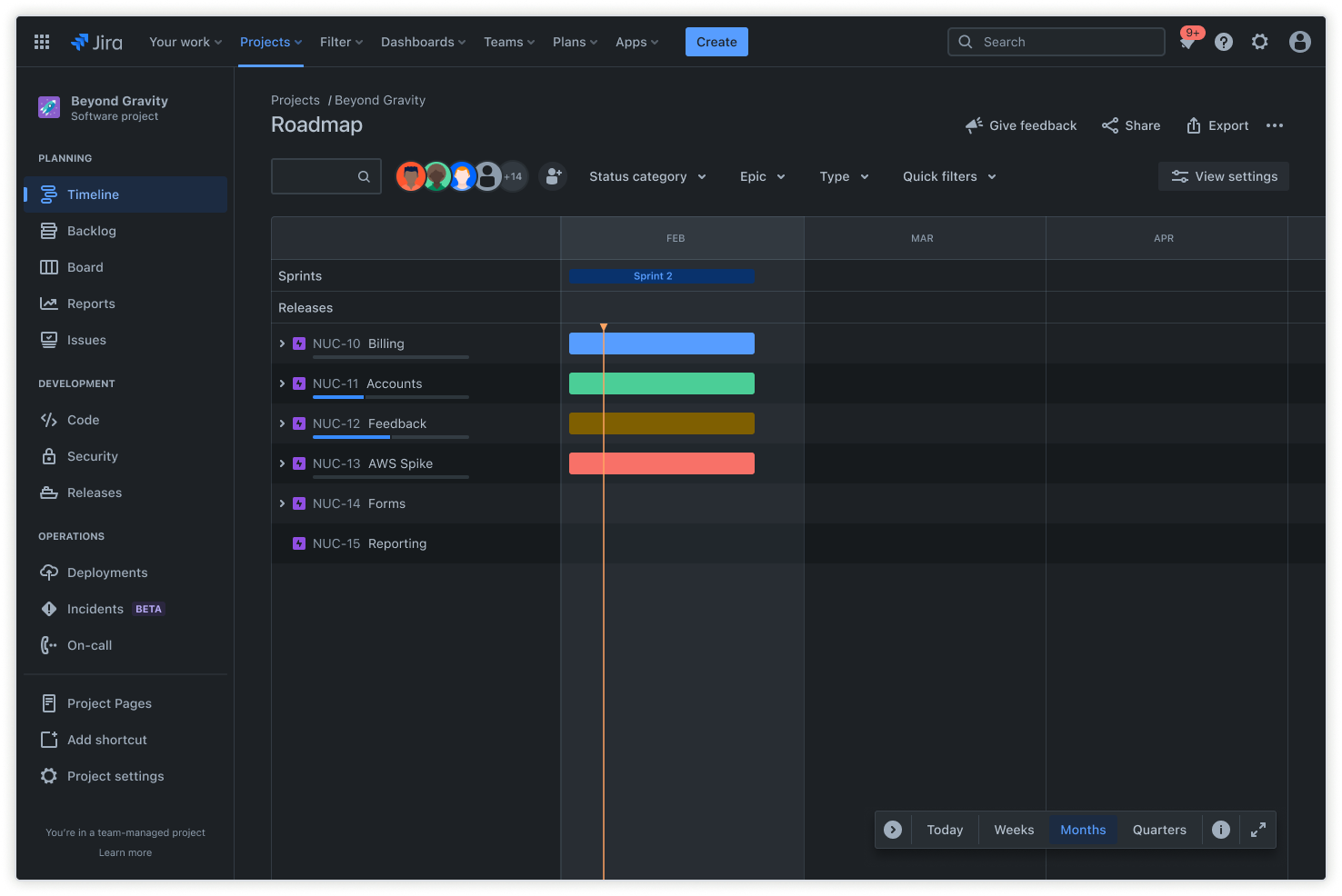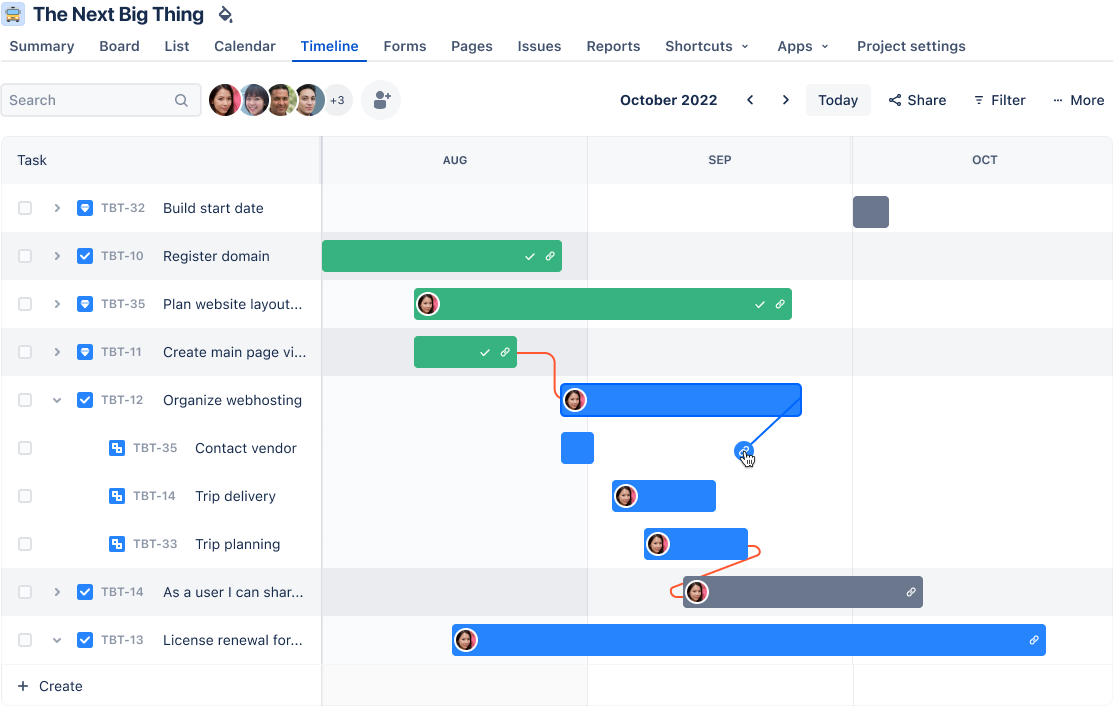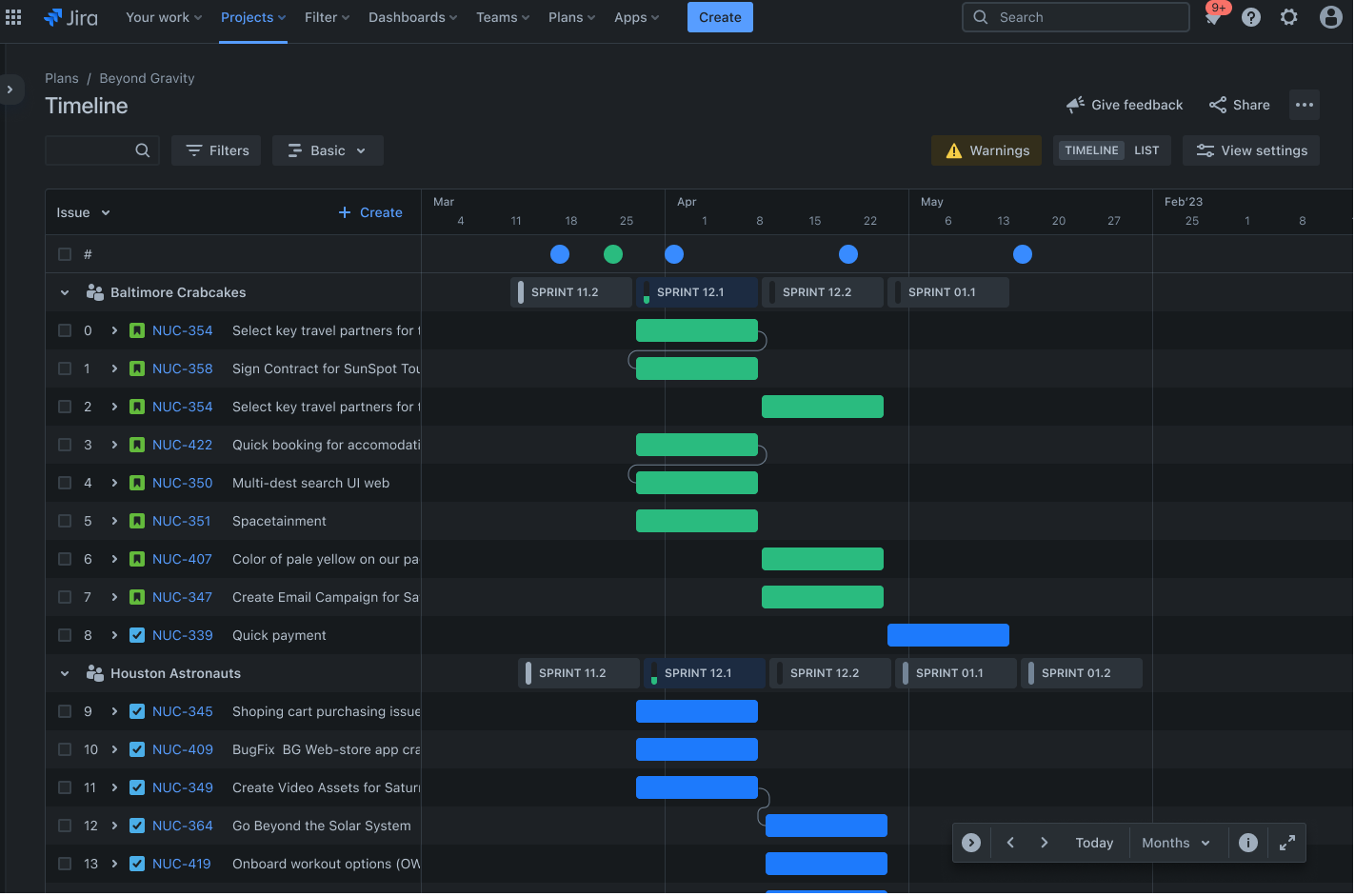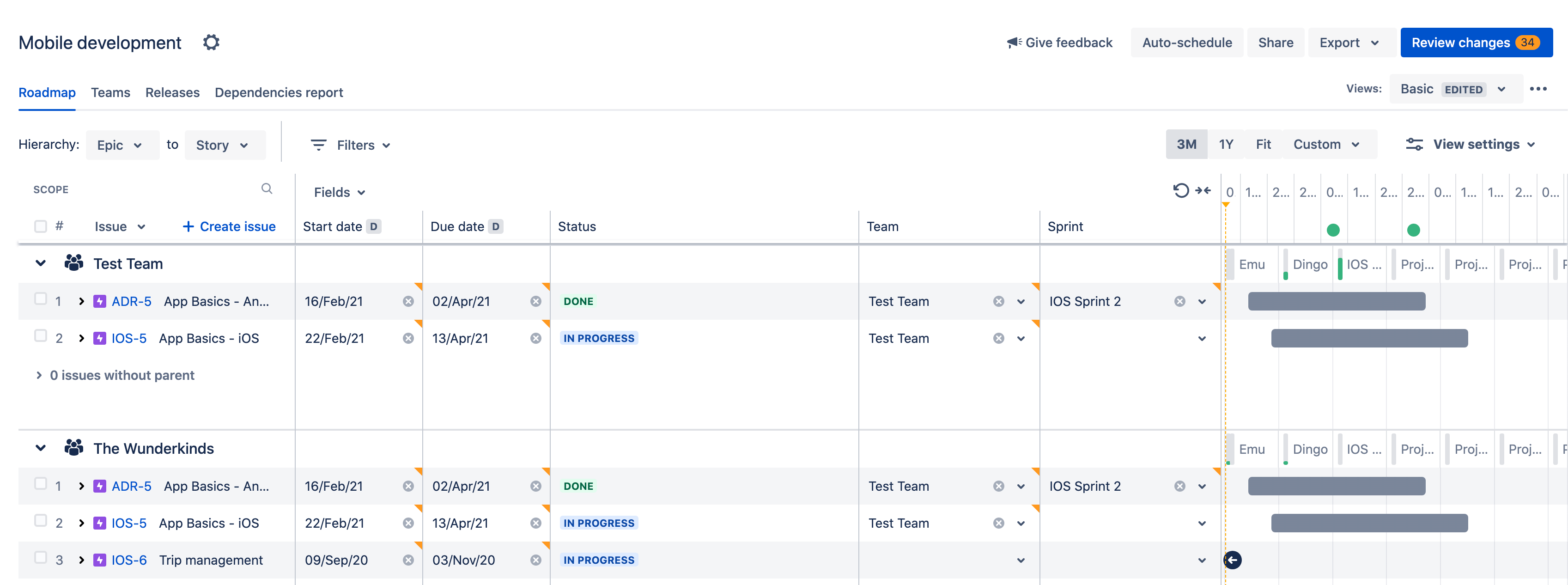Summary: A Gantt chart is a visual timeline for tracking tasks and milestones throughout a project's lifecycle. It offers a high-level overview of project schedules, making it easier to manage complex plans involving multiple teams and shifting deadlines. By providing clear visibility, Gantt charts empower project managers and teams to stay organized and focused on achieving their goals together.
Whether you're managing sprints or long-term projects, this comprehensive guide explores what Gantt charts are, their practical applications, and the many benefits they offer.
Wat is een Gantt-grafiek?
A Gantt chart is an agile project management tool used to plan and track the progress of various tasks and activities within a project. Serving as a visual timeline, it displays the list of tasks, their start and end dates, milestones, dependencies between tasks, and assignees.
As a valuable roadmap, a Gantt chart guides teams and organizations in effectively planning and coordinating their work items. By illustrating task interconnections, it fosters seamless collaboration and alignment among project stakeholders, ensuring everyone is on the same page and working towards the same goal.
De voordelen van het gebruik van Gantt-diagrammen
Gantt-diagrammen hebben twee belangrijke voordelen.
Simplifies complex planning
Gantt charts make it easier to create complex plans, particularly those involving multiple teams and shifting deadlines. They also help teams schedule tasks around deadlines and allocate resources efficiently.
Enhances task scheduling and resource allocation
Project planners rely on Gantt charts for a high-level overview, showing key details like task start and end dates, milestones, and dependencies. Modern Gantt chart programs like Jira Timelines and Jira's Advanced Planning synthesize information and illustrate how choices impact deadlines.
Gantt chart components
Gantt charts typically include two sections; the left side outlines a list of tasks, while the right side shows a project timeline with schedule bars that visualize work. Let's take a closer look at the primary components to look for in a Gantt chart.
Takenlijst

A task list is a comprehensive list of all tasks required to complete the project. In Jira, tasks can be created and managed using the issue tracker, which allows you to assign tasks to team members, set priorities, and track progress. This ensures that every team member knows their responsibilities and deadlines, promoting accountability and efficiency. For example, a software development team uses the task list to assign coding, testing, and deployment tasks to different developers, ensuring a smooth workflow.
Tijdlijn

The timeline is a visual representation of the project schedule, showing start and end dates at the top of the chart. Jira's Timeline feature provides a clear view of your project schedule, helping you visualize the sequence of tasks and their durations. Timelines help identify potential bottlenecks and allow for proactive adjustments to keep the project on track. For example, a marketing team uses the timeline to plan a product launch, ensuring all promotional activities are aligned and executed on time.
Onderlinge relaties

Links between tasks dictate the order of operations and show how tasks are related. Jira's Advanced Roadmaps allows you to set dependencies between tasks, ensuring that tasks are completed in the correct order and automatically adjusting schedules when changes occur. This prevents delays by ensuring that prerequisite tasks are completed before dependent tasks begin. In a construction project, for example, dependencies ensure that foundation work is completed before building the structure.
Mijlpalen

Project milestones on Gantt charts are markers on the project timeline indicating major progress or completion of project phases. In Jira, you can mark key milestones using milestone markers, which help keep your team focused on critical deadlines and achievements. Milestones provide motivation and a sense of accomplishment, helping teams stay focused on long-term goals. A product development team sets a milestone for completing the prototype phase, signaling readiness for user testing.
Waar worden Gantt-diagrammen voor gebruikt?
Projectmanagers gebruiken Gantt-diagrammen om drie belangrijke redenen.
Een uitgebreid project samenstellen en beheren
Gantt-diagrammen visualiseren de bouwstenen van een project en ordenen ze in kleinere, beter beheersbare taken. De resulterende taken staan in de tijdlijn van het Gantt-diagram, samen met afhankelijkheden tussen taken, uitvoerders en mijlpalen.
Logistiek en taakafhankelijkheden bepalen
Gebruik Gantt-diagrammen om de logistiek van een project te volgen. Taakafhankelijkheden zorgen ervoor dat een nieuwe taak pas kan starten als een andere taak is voltooid. Uitgestelde taken resulteren in een automatische verplaatsing. Dit kan vooral handig zijn bij het plannen in een omgeving met meerdere teams.
De voortgang van een project volgen
Terwijl teams tijd registreren voor werkitems in je plan, kun je de status van je projecten volgen en indien nodig aanpassingen maken. Een Gantt-diagram kan releasedatums, mijlpalen of andere belangrijke statistieken bevatten om de voortgang van je project bij te houden.
Een Gantt-diagram maken
Laten we, met de voordelen van Gantt-diagrammen in het achterhoofd, eens kijken hoe je je projectplannen kunt vertalen in een duidelijk en bruikbaar diagram. We behandelen de essentiële stappen, van het bepalen van de scope van je project tot het bijhouden van de voortgang, om ervoor te zorgen dat je Gantt-diagram een waardevol hulpmiddel wordt voor een succesvolle projectuitvoering.
Step 1: Define the project scope
De eerste stap bij het maken van een Gantt-diagram is het bepalen van de projectscope. Begin met het vaststellen van de belangrijkste doelstellingen van het project. Duidelijke doelstellingen dienen als leidraad voor het project en zorgen ervoor dat alle taken gedurende de hele levenscyclus van het project op deze doelen aansluiten.
Als je eenmaal je doelstellingen hebt, beschrijf dan de belangrijkste resultaten. Dit zijn de tastbare resultaten die je tijdens het hele project moet bereiken.
Step 2: List all tasks and subtasks
Maak vervolgens een lijst van alle taken die nodig zijn om elk product te voltooien. Verdeel grote taken in kleinere subtaken om duidelijk te laten zien wat je team moet doen. Identificeer elke taak, het verantwoordelijke teamlid en de benodigde resources.
Step 3: Estimate task duration
Bepaal hoe lang het duurt voordat elke taak is voltooid. Wees realistisch en houd rekening met mogelijke vertragingen. Neem buffertijd op in je planning om onverwachte vertragingen op te vangen en ervoor te zorgen dat het project op schema blijft.
Step 4: Determine task dependencies
Identificeer de taakvolgorde. Sommige taken kunnen pas beginnen als andere zijn voltooid. Gebruik afhankelijkheidstypen zoals finish-to-start of start-to-start om relaties tussen taken te definiëren.
Step 5: Choose a Gantt chart tool
Wanneer je een tool voor Gantt-diagrammen kiest, moet je verschillende factoren beoordelen om er zeker van te zijn dat de tool voldoet aan de behoeften van je project.
Jira is an excellent option for creating Gantt charts, particularly for software development teams. Tools such as Timelines and Plans help you create advanced roadmaps. These features support detailed task management, dependency tracking, and resource allocation. You can even use a Gantt chart template to streamline the process.
Step 6: Input data
Zodra je al je informatie hebt, voer je de gegevens in de door jou gekozen tool in. Voer alle taken en de bijbehorende duur in het Gantt-diagram in. Stel afhankelijkheden in tussen taken om ervoor te zorgen dat de volgorde duidelijk is. Voeg belangrijke mijlpalen toe om belangrijke punten in de projecttijdlijn onder de aandacht te brengen.
Best practices voor het opstellen van effectieve Gantt-diagrammen
Om een effectief Gantt-diagram te maken, moet je meer doen dan enkel gegevens invoeren. Hier zijn enkele best practices om te volgen.
- Hou het simpel en duidelijk. Voorkom dat je Gantt-diagram vol zit met te veel informatie. Gebruik kleuren en labels met mate en neem alleen de meest essentiële taken en afhankelijkheden op.
- Gebruik kleurcodering. Kleurcodering helpt om verschillende soorten taken of fasen beter te visualiseren. Kleurcodering verbetert de tijdlijnweergave en maakt het eenvoudiger om de voortgang in één oogopslag bij te houden.
- Communiceer duidelijk. Zorg ervoor dat alle teamleden het Gantt-diagram begrijpen door duidelijke taakbeschrijvingen, mijlpaalmarkeringen en afhankelijkheidstypen te gebruiken. Dit helpt verwarring en fouten te voorkomen.
- Deel dit met teamleden en belanghebbenden. Deel je Gantt-diagram met alle relevante belanghebbenden om ervoor te zorgen dat het hele team op één lijn zit. Houd iedereen op de hoogte van eventuele veranderingen of herzieningen van het Gantt-diagram.
- Werk het diagram regelmatig bij. Een Gantt-diagram moet een flexibel document zijn dat gedurende het hele project regelmatig wordt bijgewerkt. Breng overeenkomstige wijzigingen aan om de tijdlijn nauwkeurig te houden voor elke voltooide of uitgestelde taak.
-
Verwerk feedback. Vraag je team regelmatig om feedback en verwerk die in je Gantt-diagram om de nauwkeurigheid en effectiviteit te verbeteren.
How different stakeholders utilize Gantt charts
Gantt charts are versatile tools that cater to the diverse needs of various stakeholders within a project team. Here's how different roles utilize Gantt charts, the components they focus on, the questions they aim to answer, and the common challenges they face:
Projectmanagers
Project managers use Gantt charts to oversee the entire project timeline, manage resources, and ensure deadlines are met.
Key questions: "Are we on track to meet our deadlines?" "What resources are needed at each phase?" "How do task dependencies affect the project timeline?"
Common challenges: As a project manager, juggling complex dependencies and resource allocation can be tricky. Jira's Advanced Roadmaps feature helps by automatically adjusting schedules when dependencies change and providing a clear view of resource allocation.
Teamleden
Team members focus on their specific tasks and dependencies to understand their role in the larger project. They interact most with the task list and timeline components to track their responsibilities and deadlines.
Key questions: "What tasks am I responsible for?" "What are the deadlines for my tasks?" "How do my tasks fit into the overall project?"
Common challenges: Managing tasks and tracking changes and dependencies can be constantly shifting. Jira's real-time collaboration and issue tracker features ensure team members are always updated on task changes or dependencies shifts.
Belanghebbenden
Stakeholders view high-level progress and milestones to stay informed about the project's status. They focus on milestones and visual aids to grasp the project's progress quickly.
Key questions: "What is the current status of the project?" "Have we reached key milestones?" "Are there any major risks or delays?"
Common challenges: When trying to understand complex project details, stakeholders can feel easily overwhelmed by information. Jira's customizable views and milestone markers provide stakeholders with a clear, high-level overview of the project, ensuring they are informed without being overwhelmed.
By leveraging Jira's robust features, each stakeholder can effectively use Gantt charts to meet their specific needs, ensuring a cohesive and well-managed project.
Key features of Gantt chart software
Gantt chart software, like Jira, offers advanced features to enhance project management efficiency and effectiveness. Here's why these features are essential:
Automatic scheduling
This feature automatically adjusts timelines when task dependencies change, ensuring your project plan remains accurate and up-to-date. It saves time and reduces the risk of human error, allowing project managers to focus on strategic planning rather than manual updates.
Beheer van resources
Efficient resource allocation is crucial for project success. Effective resource management features help distribute tasks and resources across teams, optimizing workload and preventing burnout. This ensures that all team members are utilized effectively, contributing to a balanced and productive work environment.
Samenwerking in realtime
With real-time collaboration, team members can update progress and communicate changes instantly. This feature fosters transparency and keeps everyone aligned, reducing miscommunication and enhancing team cohesion. It is particularly beneficial for remote teams or projects with tight deadlines.
Customizable views
Different projects require different perspectives. Jira offers customizable views, such as daily, weekly, or monthly timelines, to suit various planning needs. This flexibility allows project managers to tailor their Gantt charts to specific project requirements, improving clarity and focus.
Integrations and compatibility
Gantt chart tools are most effective when they integrate seamlessly with other project management software and platforms. Jira excels in this area by offering robust integrations with tools like Trello and BigPicture. These integrations enable smooth project management across different systems, enhancing collaboration and efficiency.
By incorporating these features and integrations, Jira is a comprehensive solution for modern project management needs.
Gantt-diagrammen gebruiken in Jira
Jira heeft twee functies voor roadmaps, elk met een iets andere focus. Tijdlijnen van Jira houdt het werk bij dat aan één team is toegewezen, terwijl Plannen gespecialiseerd is in de planning van grotere projecten waarmee meerdere bedrijven gemoeid zijn.
Projectspecifieke diagrammen: Tijdlijnen van Jira
In de schermafbeelding hieronder, afkomstig uit Tijdlijnen, wordt een projectspecifiek Gantt-diagram getoond dat vaak wordt gebruikt op teamniveau of binnen één groep. Het diagram laat zien hoe het team zijn doelen nastreeft, en dankzij de inklapbare structuur voor werkverdeling kunnen projectmanagers de cruciale verhalen van het project in vogelvlucht bekijken. Jira heeft een gratis sjabloon voor projectbeheer met Gantt-diagrammen.

Organigram op hoog niveau: Plannen
Tijdlijnen van Jira biedt een snelle en eenvoudige planning die teams helpt hun afhankelijkheden beter te beheren en de voortgang in realtime bij te houden in het grote geheel. Deze roadmaps op project- of teamniveau zijn handig voor het plannen van grote hoeveelheden werk op teamniveau.
Plannen stelt teams in staat om op schaal te werken voor het plannen, beheren en volgen van werkzaamheden in meerdere teams of zelfs het hele bedrijf.

Programma's met teamoverschrijdende workflows bieden geavanceerdere tools zoals capaciteitsbeheer en automatische planningsfuncties om complexere plannen aan te maken. Ze bieden ook een verscheidenheid aan weergave-instellingen, waarmee je een Gantt-diagram kunt aanpassen om een bepaald aspect van je plan te benadrukken tijdens het presenteren.
Elevate your project management with Jira's Gantt charts
Transform your project management approach with the power of Gantt charts in Jira. These visual timelines are not just about tracking tasks—they're about achieving your project goals precisely and clearly. By leveraging Jira's robust features, you can create Gantt charts that are efficient and pivotal in steering your projects toward success.
Jira seamlessly integrates with various Gantt chart tools, providing a holistic project tracking and management solution. This integration ensures that your project timelines are always up-to-date, allowing real-time adjustments and insights.
Harness the full potential of Jira's capabilities to manage your Gantt charts effectively. With real-time updates, customizable dashboards, and advanced reporting, Jira empowers you to keep your projects on track and your team aligned.
Are you ready to revolutionize your project management strategy?
Gerelateerde resources
- Resources voor projectbeheer
- Resources voor de planning van projecten
- Resources voor productlancering
- Go-to-market-strategieën voor projectmanagement
- Resources voor middelenbeheer
- Resources voor het volgen van taken
- Resources voor marketingprojectmanagement
- Resources voor programmabeheer
- Resources voor projectmanagers
- Softwareprojectmanagement
